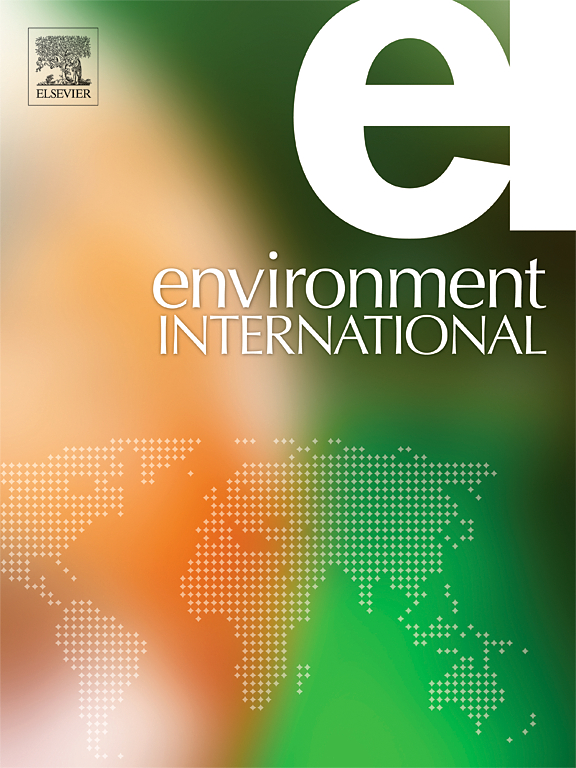Dynamic assessment of phthalate exposure: Linking internal and external monitoring in diverse indoor environments
IF 10.3
1区 环境科学与生态学
Q1 ENVIRONMENTAL SCIENCES
引用次数: 0
Abstract
Phthalates (PAEs), as prevalent endocrine disruptors, are widely distributed in indoor environments and enter the human body through dermal contact, respiratory inhalation, and ingestion, subsequently participating in metabolic processes across various organs and tissues. Existing studies primarily focus on predicting regional exposure scenarios to assess internal or external exposures risks; however, limited studies have systematically examined the correlation and discrepancies between internal and external exposures. This study collected PAEs samples from three phases (gas, particle, and dust phases) across three representative indoor environments and conducted urinary biomonitoring of phthalate metabolites (mPAEs) among exposed populations. Results showed that PAEs concentrations in the gas phase (21.67 μg·m−3) and particle phase (2.38 μg·m−3) were significantly higher in laboratories than in dormitories and offices, whereas office desktops exhibited the highest dust phase concentration (312 μg·g−1). Urinary analysis revealed distinct metabolic profiles across populations: MBP was the dominant metabolite in office and dormitory groups (median: 19.3 ng·mL−1 and 10.4 ng·mL−1, respectively), while MMP prevailed in laboratory populations (median: 18.3 ng·mL−1). Seasonal variation analysis indicated that urinary mPAEs concentrations were 4.28 times higher in summer than in winter. Demographic analysis showed that mPAEs levels were higher in males, individuals with obesity, and those with frequent plastic use compared to females, individuals with normal BMI, and those with infrequent plastic use. Furthermore, external exposure estimated from ambient PAEs concentrations exceeded internal exposure derived from urinary mPAEs concentrations by 17.3 %. These findings provide critical insights into exposure pathway differentiation and risk assessment optimization for indoor PAEs contamination.


邻苯二甲酸盐暴露的动态评估:将不同室内环境中的内部和外部监测联系起来
邻苯二甲酸酯(PAEs)是一种普遍存在的内分泌干扰物,广泛分布于室内环境中,并通过皮肤接触、呼吸吸入和摄入进入人体,随后参与各器官和组织的代谢过程。现有研究主要集中于预测区域暴露情景,以评估内部或外部暴露风险;然而,有限的研究系统地检查了内部和外部暴露之间的相关性和差异。本研究收集了三种典型室内环境中三相(气相、颗粒相和粉尘相)的PAEs样本,并对暴露人群的邻苯二甲酸酯代谢物(mPAEs)进行了尿液生物监测。结果表明,实验室中PAEs气相浓度(21.67 μg·m−3)和颗粒相浓度(2.38 μg·m−3)显著高于宿舍和办公室,而办公室桌面的PAEs尘相浓度最高(312 μg−1)。尿液分析揭示了不同人群的不同代谢特征:MBP是办公室和宿舍组的主要代谢物(中位数分别为19.3 ng·mL - 1和10.4 ng·mL - 1),而MMP在实验室人群中普遍存在(中位数为18.3 ng·mL - 1)。季节变化分析表明,夏季尿中mPAEs浓度是冬季的4.28倍。人口统计分析显示,男性、肥胖人群和经常使用塑料制品的人的mpes水平高于女性、BMI正常人群和不经常使用塑料制品的人。此外,从环境PAEs浓度估计的外部暴露比从尿液mpes浓度估计的内部暴露高出17.3% %。这些发现为室内PAEs污染的暴露途径分化和风险评估优化提供了重要见解。
本文章由计算机程序翻译,如有差异,请以英文原文为准。
求助全文
约1分钟内获得全文
求助全文
来源期刊

Environment International
环境科学-环境科学
CiteScore
21.90
自引率
3.40%
发文量
734
审稿时长
2.8 months
期刊介绍:
Environmental Health publishes manuscripts focusing on critical aspects of environmental and occupational medicine, including studies in toxicology and epidemiology, to illuminate the human health implications of exposure to environmental hazards. The journal adopts an open-access model and practices open peer review.
It caters to scientists and practitioners across all environmental science domains, directly or indirectly impacting human health and well-being. With a commitment to enhancing the prevention of environmentally-related health risks, Environmental Health serves as a public health journal for the community and scientists engaged in matters of public health significance concerning the environment.
 求助内容:
求助内容: 应助结果提醒方式:
应助结果提醒方式:


